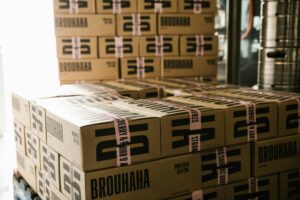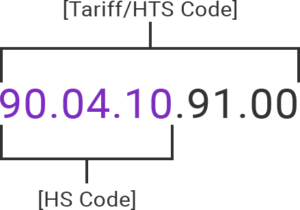Tariff codes explained – What are HS and HTS codes & why are they important?
Blog 5 mins
Topics

If you’re deciding on the best classification solution for your business, understanding the harmonised tariff code system is a good place to start.
In tariff classification, the combination of accurate data and expert knowledge is essential to assign the correct tariff code to your goods. Simply looking up a code in the tariff book or an online tool, without considering the section, chapter, and explanatory notes, often leads to a wrong classification and incorrect duty payment. This means you could be over or under paying duty costs and your business could be in line to save money if you implement a better classification solution. You also run the risk of being non-compliant with trade regulations if codes are incorrect. This has consequences and makes trade compliance a major priority for businesses today.
If your business is classifying 500+ SKUS on a regular basis each week, does your team have the time or knowledge to go into detail on every code to ensure accuracy? You may think that new AI solutions that have recently come to market are the answer. In our experience, they fall short when it comes to guaranteeing accuracy of tariff codes, and the combination of advanced customs technology and tariff code expertise is the answer with major brands such as M&S and ASDA agreeing and using our trusted TariffTel solution to classify goods.
Here we look in detail at what makes up a tariff code and how duty is assigned. Understanding the harmonised system and the way it works, can support your decision in finding the right tariff code solution for your business.

Why do we need tariff codes?
The primary use is to categorise goods for exporting and importing internationally. We have a standardised system that ensures consistency in how products are classified across different countries and customs authorities.
The Harmonised System (HS) is an internationally recognised nomenclature developed by the World Customs Organization (WCO). Each product is assigned a unique HS code, typically comprising six to ten digits. This alphanumeric code provides a standardised and universally understood means of categorising goods.
Tariff codes are then used to determine the appropriate tariffs and duties applicable to specific goods and used by customs authorities to identify and track shipments.
A correct code means a correct duty payment and ultimately, trade compliance.
What’s the difference between HS code, HTS code and tariff codes?
There are a few variations of codes you may see. It’s important to know the difference between them.
HS Codes
HS codes are six-digit codes that classify goods based on their nature, form, and composition. The first two digits of a HS code identify the chapter, the next two digits identify the heading, and the final two digits identify the subheading. HS codes are used by 212 countries worldwide. Whilst some countries adopt the 6-digits without modification, most extend to 7-12 digits to be even more precise. Read more about HS Codes.
HTS Codes
In the US, the Harmonised Tariff Schedule (HTS) is maintained by the U.S. International Trade Commission (USITC) and is used to determine the tariff rates that apply to goods imported into the United States. The WCO provides the first six digits and the HTSUS provides the final four for additional detail. Each country maintains its own Harmonised Tariff Schedule (or similarly named).
Tariff Codes/Commodity Codes
Tariff codes or commodity codes are classification codes used to determine the customs duty that is applied to a particular product. These codes are ten digits long for imports, eight digits for export, and are used to identify specific products. The HS code makes up the first six digits whilst the final four digits are unique to each country’s tariff system, and they provide additional detail that is specific to that country’s classification systems.
Understanding the tariff code structure
A tariff code structure is complex and made up of various parts. It is based on the chapter number, heading and subheading codes of the HS nomenclature. The correct code is assigned by understanding the nuances of the chapter and heading notes which only an expert can interpret and advise on.

Chapter: The first two digits of the HS code represent the chapter, which broadly categorises goods into overarching groups. There are 99 chapters in total, each covering a specific range of products. For example, Chapter 90 is dedicated to “Optical, photographic, cinematographic, measuring, checking, precision medical or surgical instruments and apparatus; parts and accessories thereof”
Heading: The next two digits further specify the product within a chapter and are known as the heading. This level of classification provides more detail about the type of goods. Following the example above, heading 04 corresponds to “Spectacles, goggles and the like, corrective, protective or other”
Subheading: The following two digits form the subheading, offering even more precision in describing the product. Continuing with our example, subheading 10 refers to Sunglasses
Tariff Item: Some countries add two additional digits to the HS code, creating a more detailed classification known as the tariff item. This level of specificity is particularly useful for accurate customs assessment. For instance, 90.04.10.91 represents “Sunglasses with lenses of plastics which are not optically worked.”
Take a look at how some seemingly straight forward products from our customer M&S, can be complex to classify without the right knowledge.
Understanding the structure and significance of the HS code is fundamental for anyone engaged in international trade. From customs classification managers to business owners, a grasp of this universal classification system facilitates smoother transactions, enables accurate documentation, and contributes to the efficiency of the global supply chain.
Having the right classification solution in place for your business is an indispensable tool that supports your trade in the connected global economy. TariffTel’s combination of advanced customs data and our unrivalled team expertise create a leading solution for every business prioritising trade efficiency and growth.
If you want to find out more about a tariff code solution that’s right for your business or want to learn how your business could benefit from TariffTel, get in touch with our team.
Other useful resources
Team spotlight – Elizabeth Davies, Customs Systems Manager
This month it's our Customs System's Manager, Elizabeth Davies, taking a turn in the hot s...
How TariffTel transforms your approach to customs classification
International trade today is a dynamic and evolving world to operate in. Whichever sector ...
How technology integration is transforming customs classification
In today's rapidly evolving global marketplace, the successful adoption and integration of...



